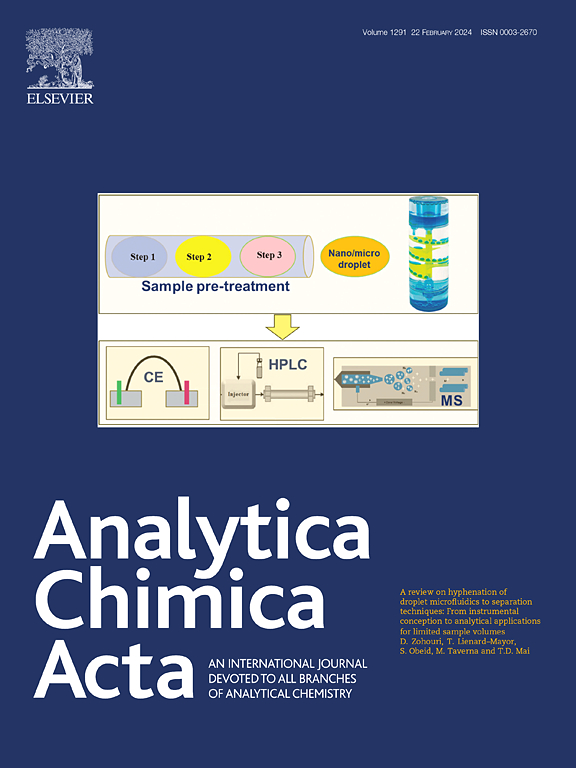FTW SERS probes with Ag NCs-GO composite structure excited by evanescent wave for in situ detection of permethrin
IF 6
2区 化学
Q1 CHEMISTRY, ANALYTICAL
引用次数: 0
Abstract
Background
Permethrin is a pesticide used to kill insects, and once used in excess, it poses a great threat to the environment and human health, therefore, it is necessary to realize the rapid and accurate detection of permethrin. Fiber optic surface enhanced Raman scattering (SERS) probes have the advantages of small volume and can be used for remote monitoring, which have great potential for application in achieving in-situ detection of pesticide residues.
Results
Fiber taper waist (FTW) SERS probes modified by silver nanocubes-graphene oxide (Ag NCs-GO) composite structures were prepared for in situ detection of permethrin in lake water. Evanescent wave was used to excite SERS signals from Ag NCs-GO composite substrates, which was designed to enhance signals through expanded excitation light-analyte contact area. Ag NCs can provide stronger hot spots, and GO further enhances the sensitivity of SERS through electron transfer and improves the stability of the detection. The detection limit of prepared FTW SERS probe for Rhodamine 6G (R6G) was calculated to be 8.5 × 10−9 M and RSD were all below 5 % using the drop-casting method. The in-situ detection limit of R6G and permethrin in water was tested to be 10−6 M and 10−5 M, respectively.
Significance
This work utilizes fiber optic evanescent waves to excite SERS signals, and adopts a special FTW structure and SERS substrates to achieve good performance. The synergistic enhancement of electromagnetism and chemistry is realized while increasing the contact area, which improves the sensitivity of in situ detection of the pesticide residue permethrin. It Promotes the application of fiber optic SERS sensors in pesticide residue detection.


瞬变波激发Ag - NCs-GO复合结构FTW SERS探针原位检测氯菊酯
氯菊酯是一种用于杀虫的农药,一旦过量使用,将对环境和人体健康造成极大威胁,因此,有必要实现氯菊酯的快速、准确检测。光纤表面增强拉曼散射(SERS)探针具有体积小、可远程监测等优点,在实现农药残留的原位检测方面具有很大的应用潜力。结果制备了纳米银-氧化石墨烯复合结构修饰的光纤锥形腰(FTW) SERS探针,用于湖泊水中氯菊酯的原位检测。利用倏逝波激发Ag - NCs-GO复合衬底的SERS信号,通过扩大激发光分析物接触面积来增强信号。Ag纳米碳可以提供更强的热点,氧化石墨烯通过电子转移进一步提高SERS的灵敏度,提高检测的稳定性。采用滴铸法计算制备的FTW SERS探针对罗丹明6G (R6G)的检出限为8.5×10-9 M, RSD均小于5%。水中R6G和氯菊酯的原位检出限分别为10-6 M和10-5 M。本工作利用光纤倏逝波激发SERS信号,采用特殊的FTW结构和SERS衬底实现了良好的性能。在增加接触面积的同时,实现了电磁与化学的协同增强,提高了氯菊酯农药残留原位检测的灵敏度。促进了光纤SERS传感器在农药残留检测中的应用。
本文章由计算机程序翻译,如有差异,请以英文原文为准。
求助全文
约1分钟内获得全文
求助全文
来源期刊

Analytica Chimica Acta
化学-分析化学
CiteScore
10.40
自引率
6.50%
发文量
1081
审稿时长
38 days
期刊介绍:
Analytica Chimica Acta has an open access mirror journal Analytica Chimica Acta: X, sharing the same aims and scope, editorial team, submission system and rigorous peer review.
Analytica Chimica Acta provides a forum for the rapid publication of original research, and critical, comprehensive reviews dealing with all aspects of fundamental and applied modern analytical chemistry. The journal welcomes the submission of research papers which report studies concerning the development of new and significant analytical methodologies. In determining the suitability of submitted articles for publication, particular scrutiny will be placed on the degree of novelty and impact of the research and the extent to which it adds to the existing body of knowledge in analytical chemistry.
文献相关原料
公司名称
产品信息
阿拉丁
Glucose anhydrous
阿拉丁
Cetyltrimethyl ammonium bromide (CTAB)
阿拉丁
Aqueous ammonia
阿拉丁
Rhodamine 6G (R6G)
阿拉丁
Permethrin
 求助内容:
求助内容: 应助结果提醒方式:
应助结果提醒方式:


